Since Payara Server 4.1.2.183 and 5.183
The Payara API provides a @OpenIdAuthenticationDefinition annotation that creates an authorization mechanism for OpenID Connect support.
This works in the same way as other authorization mechanisms in the Java EE Security API.
Usage
The OpenID Connect authentication mechanism is defined through the @OpenIdAuthenticationDefinition annotation.
Specifying this in a valid place as defined by the Java EE Security API will create the mechanism.
Often this may mean that any class is a valid position.
Example
Here’s an example that configures a OpenID Connect client:
@OpenIdAuthenticationDefinition(
providerURI = "https://sample-openid-server.com",
clientId = "87068hgfg5675htfv6mrucov57bknst.apps.sample.com",
clientSecret = "{my-secret}",
redirectURI = "${baseURL}/callback",
extraParameters = {
"testKey=testValue",
"testKey2=testValue2"
}
)
public class SecurityBean {
}See this sample project for a more detailed example.
When defining a OpenID Connect flow within an application deployed on Payara Server, it is possible to retrieve the access token, identity token, user claims and the other authentication information within any bean in the scope of the callback/redirectURI resource used to configure the authentication:
@WebServlet("/callback")
public class CallbackServlet extends HttpServlet {
@Inject
OpenIdContext context;
@Override
protected void doGet(HttpServletRequest request, HttpServletResponse response) throws ServletException, IOException {
PrintWriter out = response.getWriter();
//Here's the caller name
out.println(context.getCallerName());
//Here's the caller groups
out.println(context.getCallerGroups());
//Here's the unique subject identifier within the issuer
out.println(context.getSubject());
//Here's the access token
out.println(context.getAccessToken());
//Here's the identity token
out.println(context.getIdentityToken());
//Here's the user claims
out.println(context.getClaimsJson());
}
}Since Payara Server 5.2020.5
The original protected URL called is stored so that a redirect can be issued to this page after the callback from the OpenIdConnect provider is handled.
| Only some basic redirect is supported namely a GET. Only the URL and query parameters are available, not the headers and the request body. |
@Override
protected void doGet(HttpServletRequest request, HttpServletResponse response) throws ServletException, IOException {
// handling the OpenIdContext information. See previous example
// Now return to original requested page
response.sendRedirect(request.getSession().getAttribute(OpenIdConstant.ORIGINAL_REQUEST).toString());
}Configuration
OpenID Client can be configured with both @OpenIdAuthenticationDefinition annotation attributes and Microprofile Config properties.
When you provide configuration using MicroProfile Config properties and you use a reference to a variable provided by Payara using the ${} notation inside the values, you need to escape the $ sign with \\. Otherwise they will be treated as references to other MicroProfile Config properties, which may result in an error if such a MicroProfie property isn’t found. This especially applies to the baseURL variable, which is only accepted in the value of the redirectURI option. For example, to specify redirectURI using a MicroProfile Config property which is equal to ${baseURL}/Callback used in the annotation, you need to use the following MicroProfile Config key=value definition: payara.security.openid.redirectURI=\\${baseURL}/Callback.
|
The annotation and MicroProfile properties has several configuration options. They are detailed below.
| Option | MP Config property | Required | Description | Default value | Requirements |
|---|---|---|---|---|---|
|
|
true |
The provider uri to discover the metadata of the OpenID Connect provider. |
The endpoint must be HTTPS. |
|
|
|
true |
The client identifier issued when the application was registered. |
N/A. |
|
|
|
true |
The client secret for the registered application. |
N/A. |
|
|
|
true |
The URL to redirect the user to upon successful authentication. Can include the variable ${baseURL}, which is replaced by the URL of the application’s context path (e.g. |
${baseURL}/Callback |
Must be equal to one set in the OpenID Connect provider. |
|
|
false |
The scopes requested from the OpenID Connect provider. |
{openid, email, profile} |
N/A. |
|
|
false |
Response Type value defines the processing flow to be used. |
code |
N/A. |
|
|
false |
Informs the Authorization Server of the mechanism to be used for returning parameters from the Authorization Endpoint. |
N/A. |
|
|
|
false |
The prompt value specifies whether the authorization server prompts the user for re-authentication and consent. |
N/A. |
|
|
|
false |
The display value specifying how the authorization server displays the authentication and consent user interface pages. |
page |
N/A. |
|
|
false |
Enables string value used to mitigate replay attacks. |
true |
N/A. |
|
|
false |
If enabled state & nonce value stored in session otherwise in cookies. |
true |
N/A. |
|
|
false |
Sets the connect timeout(in milliseconds) for Remote JWKS retrieval. |
500 |
Value must not be negative and if value is zero then infinite timeout. |
|
|
false |
Sets the read timeout(in milliseconds) for Remote JWKS retrieval. |
500 |
Value must not be negative and if value is zero then infinite timeout. |
|
|
false |
Enables or disables the automatically performed refresh of Access and Refresh Token. Since Payara Server 5.193 |
false |
N/A. |
|
|
false |
Sets the minimum validity time(in milliseconds) the Access Token must be valid before it is considered expired. Since Payara Server 5.193 |
10000 |
Value must not be negative. |
|
|
false |
Defines the name of callerName claim and maps the claim’s value to caller name value in IdentityStore#validate. Since Payara Server 5.184 |
preferred_username |
N/A. |
|
|
false |
Defines the name of callerGroups claim and maps the claim’s value to caller groups value in IdentityStore#validate. Since Payara Server 5.184 |
groups |
N/A. |
|
false |
An array of extra options to be sent to the OpenID Connect provider. |
Must be in the form |
||
|
@LogoutDefinition |
Defines the functionality that is performed when the user logs out and defines the RP Session Management configuration. |
Note : If both an annotation attribute and a MicroProfile Config property are defined for the same option
then the MicroProfile Config property value always takes precedence over the @OpenIdAuthenticationDefinition annotation value.
Expression Language Support
Additionally, the @OpenIdAuthenticationDefinition supports the use of expression language (EL) notation for dynamic configuration scenarios.
This means that you can use any CDI bean properties to set the OpenID Connect configuration like this:
@OpenIdAuthenticationDefinition(
providerURI="#{openidConfigBean.tokenEndpointURL}",
clientId="#{openidConfigBean.clientId}",
clientSecret="#{openidConfigBean.clientSecret}",
redirectURI="#{openidConfigBean.redirectURI}"
)
public class SecurityBean {
}Logout functionality
Since 5.2020.3
With the logout parameter of the OpenIdAuthenticationDefinition you can define the behavior when the user logs out of the application and defines how the RP session is managed.
| Option | MP Config property | Required | Description | Default value |
|---|---|---|---|---|
|
payara.security.openid.provider.notify.logout |
false |
Notify the OIDC provider (OP) that the user has logged out of
the application and might want to log out of the OP as well. If true then
after having logged out the user from RP, redirects the End-User’s User
Agent to the OP’s logout endpoint URL. This URL is normally obtained via
the |
false |
|
payara.security.openid.logout.redirectURI |
false |
The post logout redirect URI to which the RP is requesting that the End-User’s User Agent be redirected after a logout has been performed. If redirect URI is empty then redirect to OpenID connect provider authorization_endpoint for re-authentication. |
|
|
payara.security.openid.logout.access.token.expiry |
false |
Whether the application session times out when the Access Token expires. |
false |
|
payara.security.openid.logout.identity.token.expiry |
false |
Whether the application session times out when the Identity Token expires. |
false |
A programmatic logout is performed by calling OpenIdContext#logout() which invalidates the RP’s active OpenId Connect session. If fish.payara.security.annotations.LogoutDefinition#notifyProvider is set to true then it redirects the End-User’s User Agent to the end_session_endpoint to notify the OP that the user has logged out of the RP’s application. It will also ask the user whether they want to logout from the OP as well. After successful logout, the End-User’s User Agent redirects back to the RP’s post_redirect_uri configured via fish.payara.security.annotations.LogoutDefinition#redirectURI.
Client Secret Aliasing
The client secret can be input directly, or for added security it can be aliased using any of the following features:
Fetch Caller Data
As OpenId Connect Client is built on top of Jakarta EE Security API,
therefore javax.security.enterprise.SecurityContext interface can provide
caller info which is available as a CDI bean and can be injected into any context-aware instance.
The Payara API also provides a fish.payara.security.openid.api.OpenIdContext
interface which is also available as a CDI bean and consist of the following methods:
-
The
getCallerName()method - Gets the caller name of the currently authenticated user. -
The
getCallerGroups()method - Gets the groups associated with the caller. -
The
getSubject()method - Subject Identifier. A locally unique and never reassigned identifier within the Issuer for the End-User, which is intended to be consumed by the Client. -
The
getTokenType()method - Gets the token type value. The value MUST be Bearer or another token_type value that the Client has negotiated with the Authorization Server. -
The
getAccessToken()method - Gets the authorization token that was received from the OpenId Connect provider. -
The
getIdentityToken()method - Gets the identity token that was received from the OpenId Connect provider. -
The
getRefreshToken()method - Returns the refresh token that is used by OIDC client to get a new access token. -
The
getExpiresIn()method - Return the time that the access token is granted for, if it is set to expire. -
The
getClaimsJson()method - Gets the User Claims JSON that was received from the userinfo endpoint. -
The
getClaims()method - Gets the User Claims that were received from the userinfo endpoint. -
The
getProviderMetadata()method - The OpenId Connect Provider’s metadata document fetched via provider URI.
Google integration
The Payara API provides the in-built support for Google OpenID Provider via the @GoogleAuthenticationDefinition annotation.
Request Refresh Token
To enable the refresh token feature, set the tokenAutoRefresh to true
and add the access_type parameter value to offline
so that application can refresh access tokens when the user is not present at the browser.
If application requests offline access then the application can receive access and refresh token.
Once the application has a refresh token, it can obtain a new access token at any time or as older ones expire.
Otherwise, If application requests online access, your application will only receive an access token
@GoogleAuthenticationDefinition(
providerURI="#{openidConfigBean.tokenEndpointURL}",
clientId="#{openidConfigBean.clientId}",
clientSecret="#{openidConfigBean.clientSecret}",
...
tokenAutoRefresh = true,
extraParameters = {"access_type=offline", "approval_prompt=force"}
)
public class SecurityBean {
}Azure AD integration
The Payara API also provides the in-built support for Azure AD OpenID Provider via the @AzureAuthenticationDefinition annotation.
Request Refresh Token
To receive the refresh token, set the tokenAutoRefresh to true and explicitly add the offline_access scope to the definition.
@AzureAuthenticationDefinition(
providerURI="#{openidConfigBean.tokenEndpointURL}",
clientId="#{openidConfigBean.clientId}",
clientSecret="#{openidConfigBean.clientSecret}",
...
tokenAutoRefresh = true,
scope = {OPENID_SCOPE, EMAIL_SCOPE, PROFILE_SCOPE, OFFLINE_ACCESS_SCOPE}
)
public class SecurityBean {
}Groups mapping
-
To add the groups to the registered application, Sign in to the Azure portal > Azure Active Directory > Manage > App registrations > select your application:
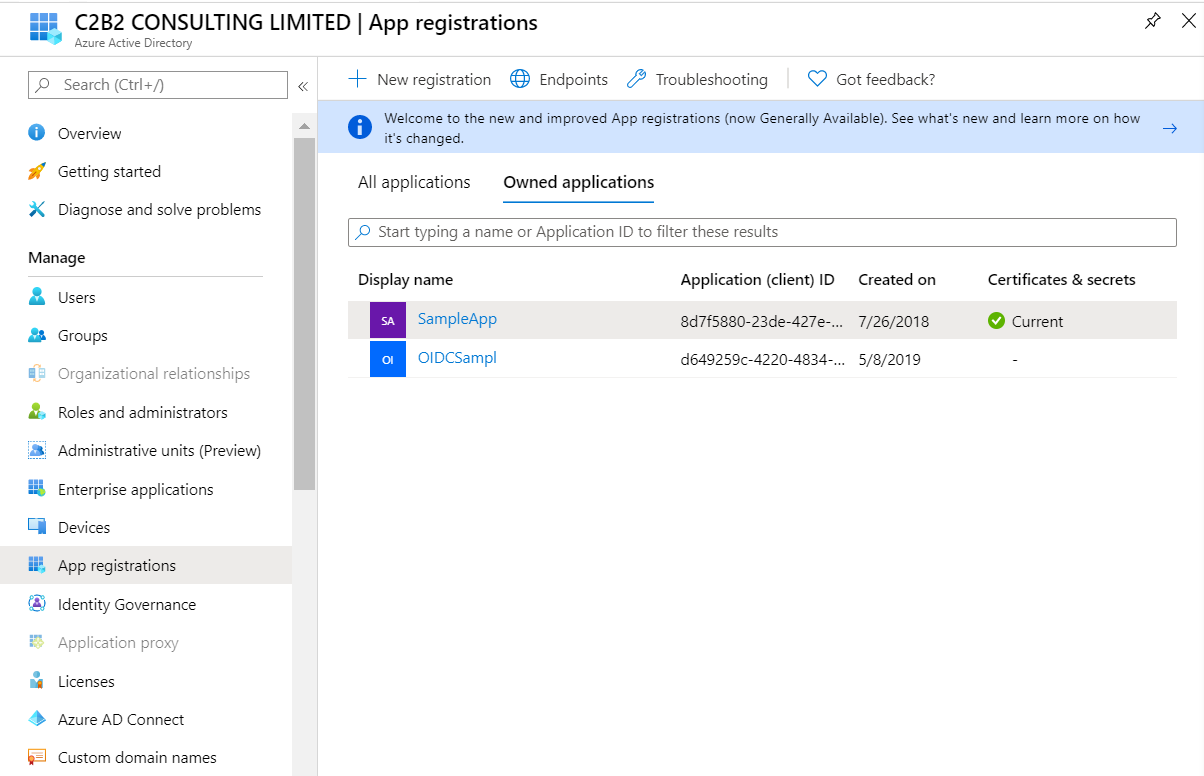
-
You may also add the custom roles via Roles and administrators under the Manage section:

-
Now to map group claims, select Token configuration under the Manage section:
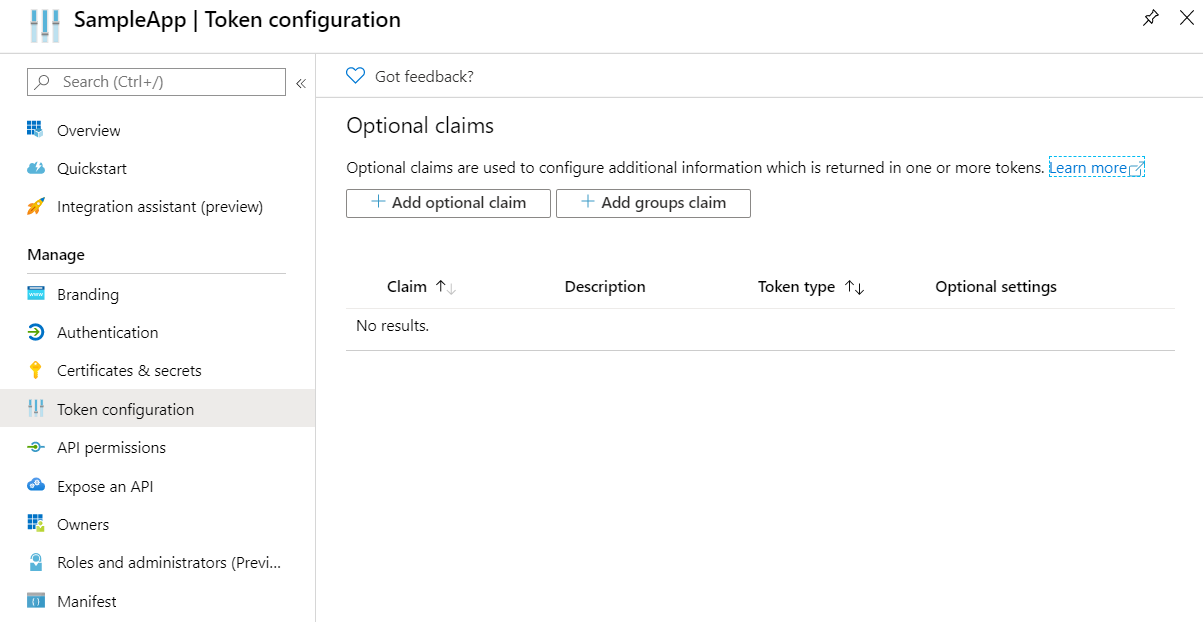
-
Press Add groups claim button to select group types and customize Id and/or Access token properties:

-
Groups claim can also be defined via Azure Manifest under the Manage section which is a JSON configuration file.
-
To retrieve and map the caller name & groups from token claims, set the caller name & group claim definition to
preferred_username&groups.
@AzureAuthenticationDefinition(
providerURI="#{openidConfigBean.tokenEndpointURL}",
clientId="#{openidConfigBean.clientId}",
clientSecret="#{openidConfigBean.clientSecret}",
...
claimsDefinition = @ClaimsDefinition(
callerGroupsClaim = "groups",
callerNameClaim = "preferred_username"
)
)
public class SecurityBean {
}
Keycloak integration
Keycloak is Open Source Identity and Access Management Server, which is a OAuth2 and OpenID Connect(OIDC) protocol complaint. In this section, the basic steps are described to setup Keycloak OpenId provider.For more details about Keycloak configuration options, please visit to the official documentation: https://www.keycloak.org/documentation.html
-
Refer Keycloak getting started documentation to run and setup keycloak.
-
After Keycloak setup done, login to Keycloak admin console and add the new realm by pressing the Add Realm button:
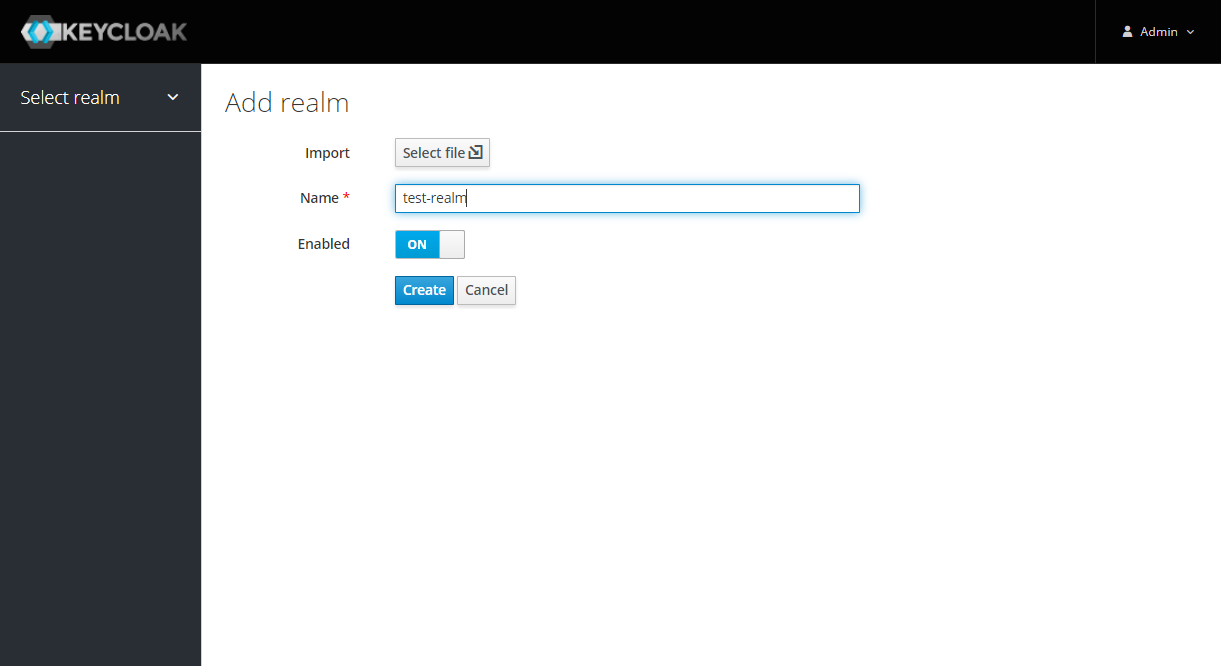
-
Copy the OpenId endpoint configuration URL from endpoint section:
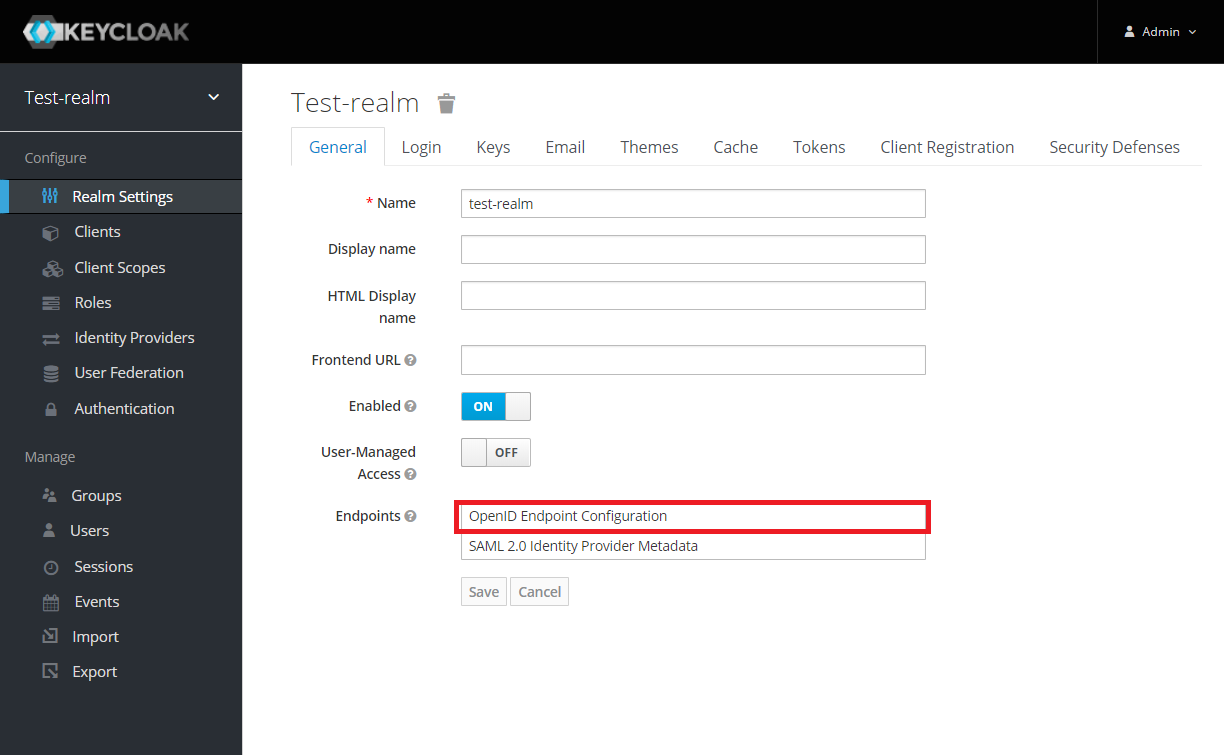
-
Now add the Role that will be used by the application to define which users will be authorized to access the application.
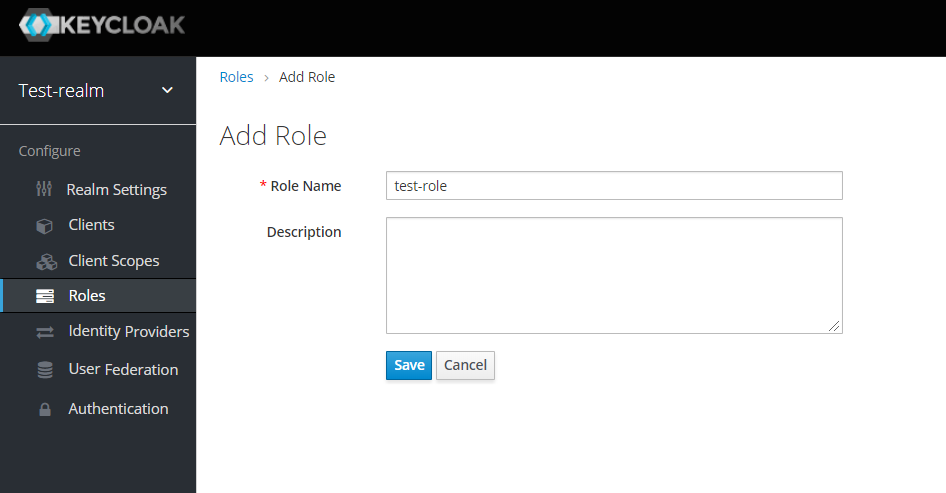
-
Create the Groups:

-
Add the User:

-
After the user is created, set a new password for the user:
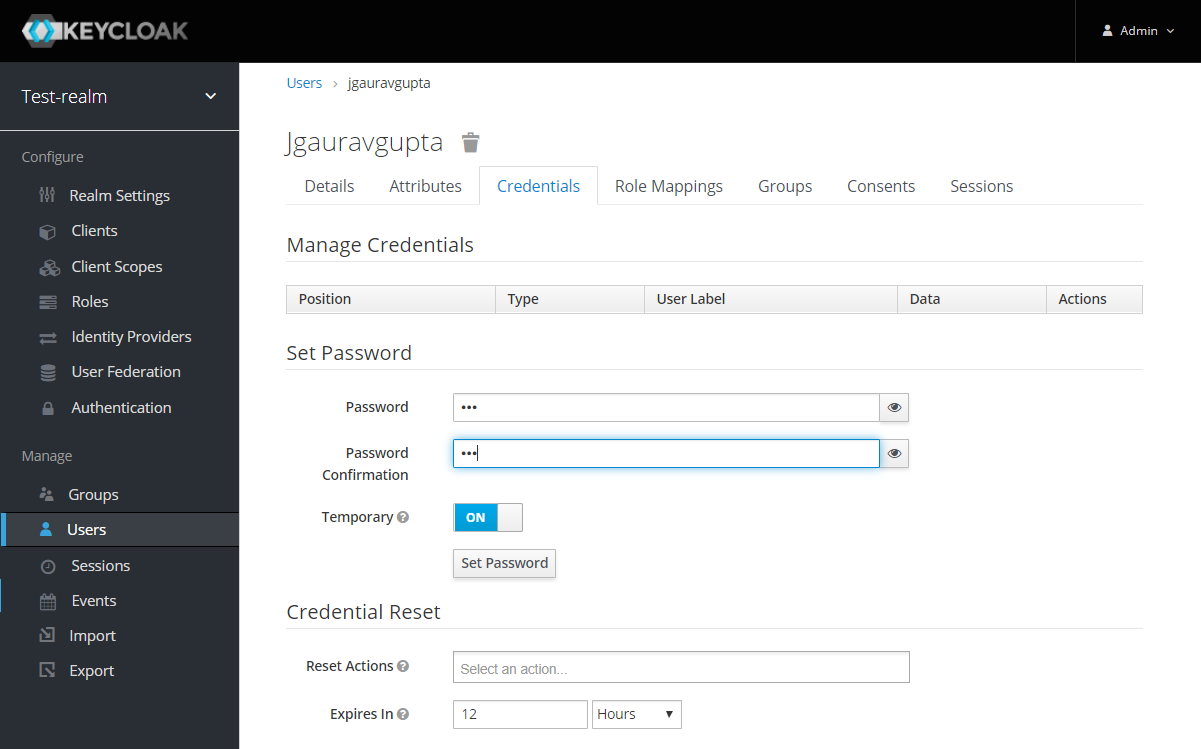
-
Now map the user to roles. Click on Role Mappings tab and assign the roles to the user from the available roles:
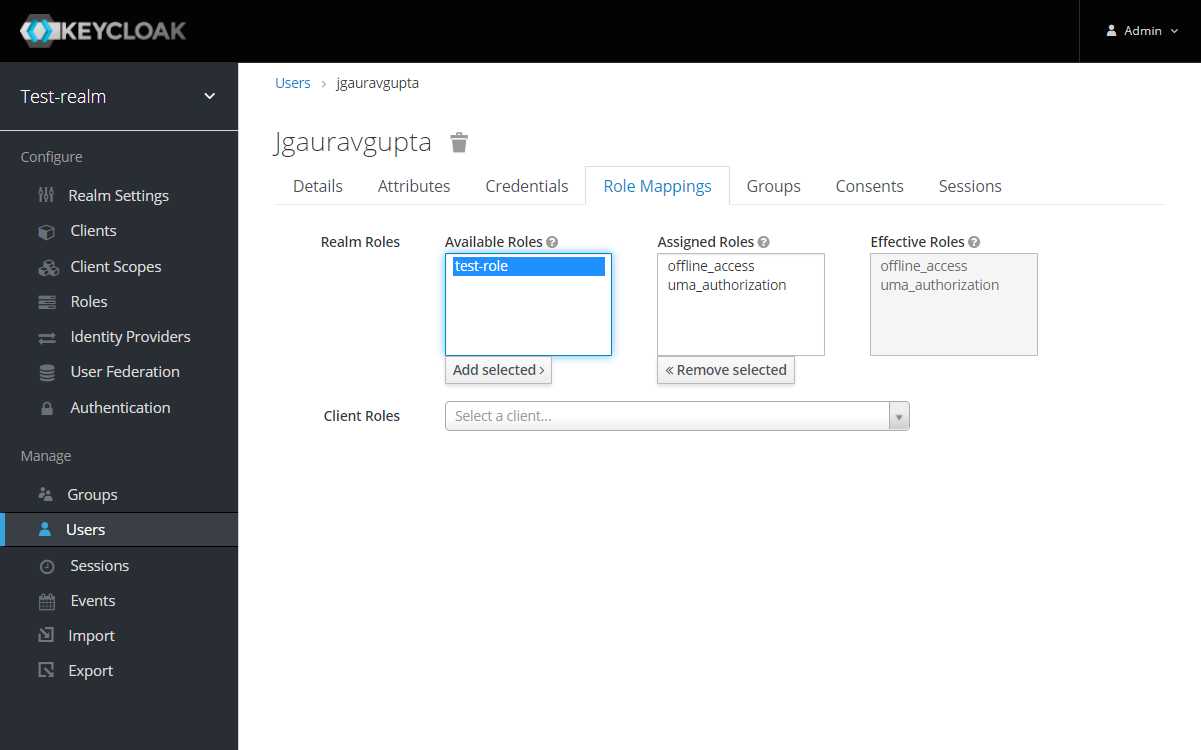
-
Assign the user to the groups. Click on Groups tab and join the groups from the available groups:

-
Create the OpenId Client by clicking the Client option from sidebar and press the create button:
 Enter the Client ID and select the Client Protocol openid-connect and press Save.
Enter the Client ID and select the Client Protocol openid-connect and press Save. -
After the openid client is created change its Access Type to confidential and enter the valid Redirect URIs:
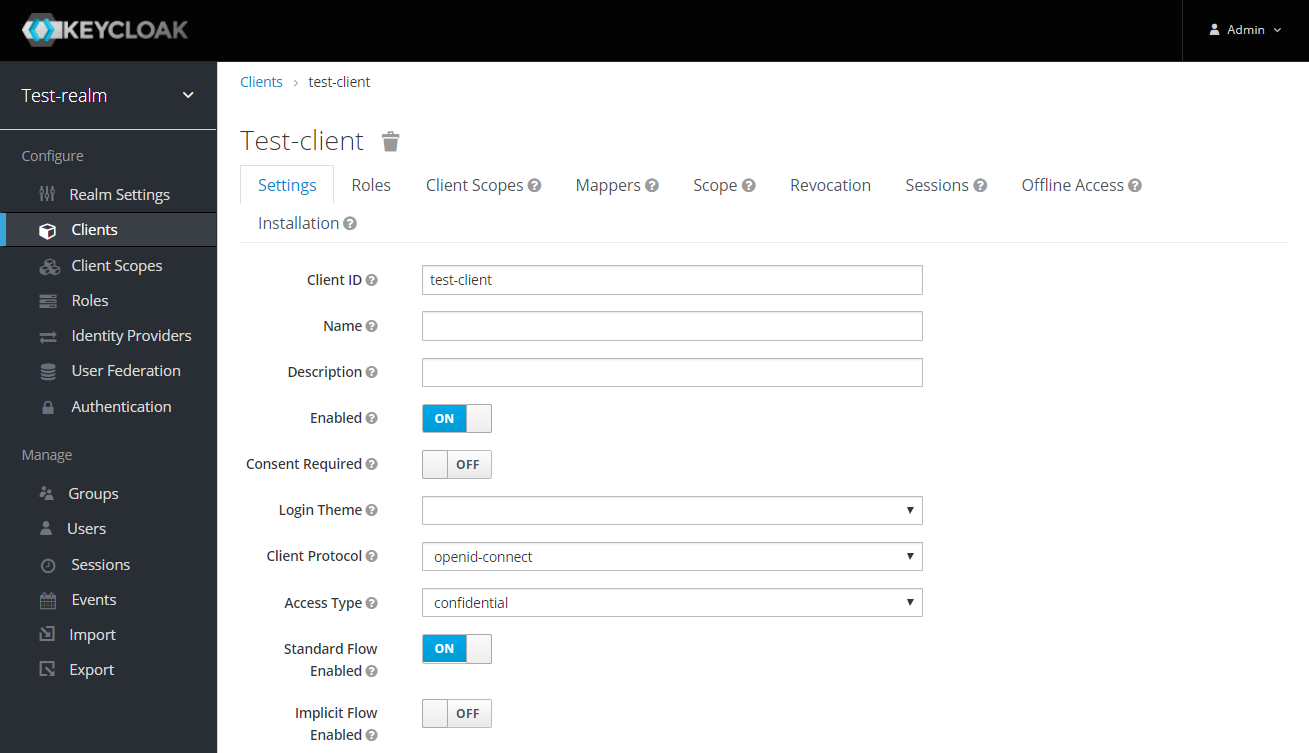
-
Next copy the client secret from Credentials tab.
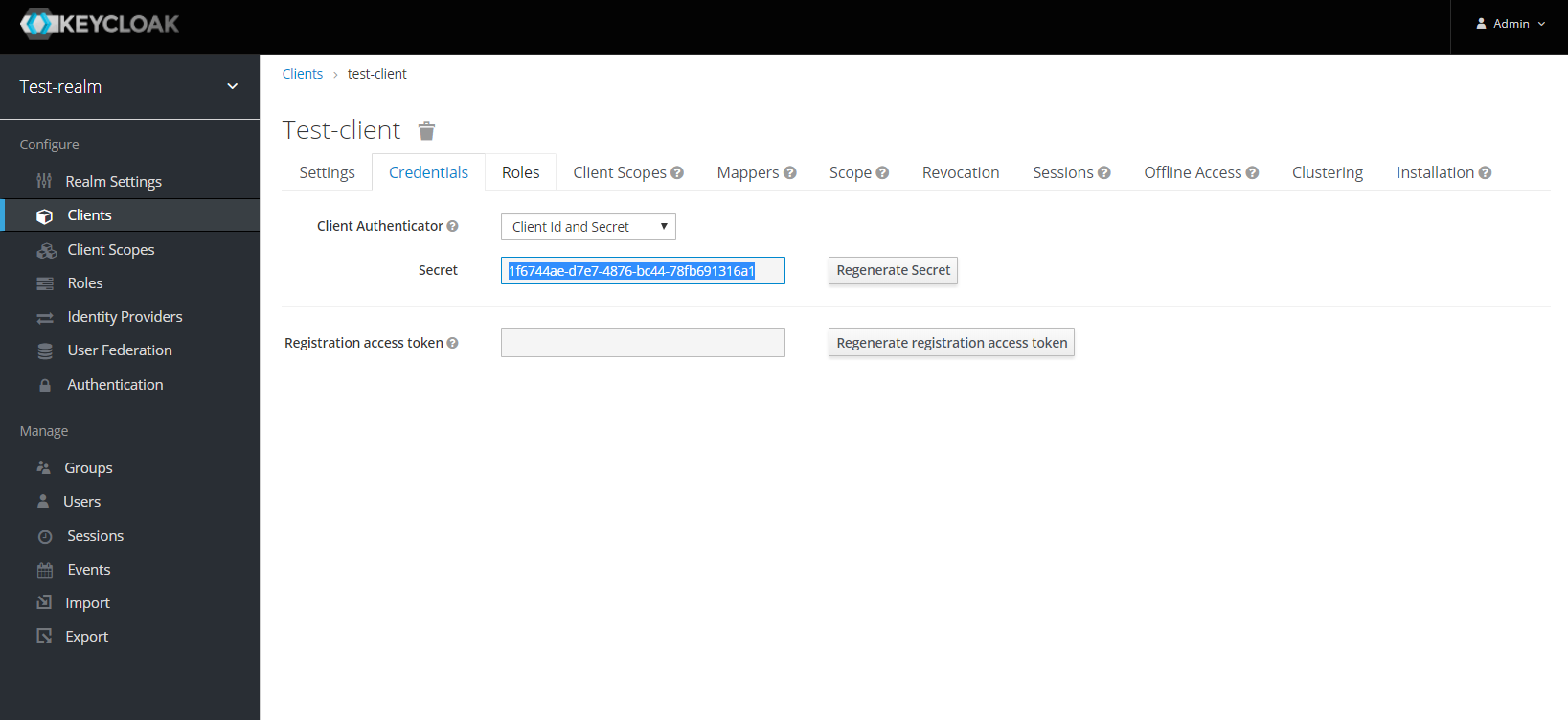
Here’s an example that configures a OpenID Connect client for Keycloak provider. To test the KeyCloak OpenId provider, enter the copied Client Secret, Client ID (client name) and the endpoint configuration URL:
@OpenIdAuthenticationDefinition(
providerURI = "http://${keycloak-host}:${keycloak-port}/auth/realms/test-realm",
clientId = "test-client",
clientSecret = "1f6744ae-d7e7-4876-bc44-78fb691316a1"
...
)
public class SecurityBean {
}Groups mapping
-
To get the groups details in token claims, navigate to Keycloak admin console > OpenId Client > Mappers tab > press create button > Select Group Membership mapper type > enter the Name and Token Claim Name > press Save.
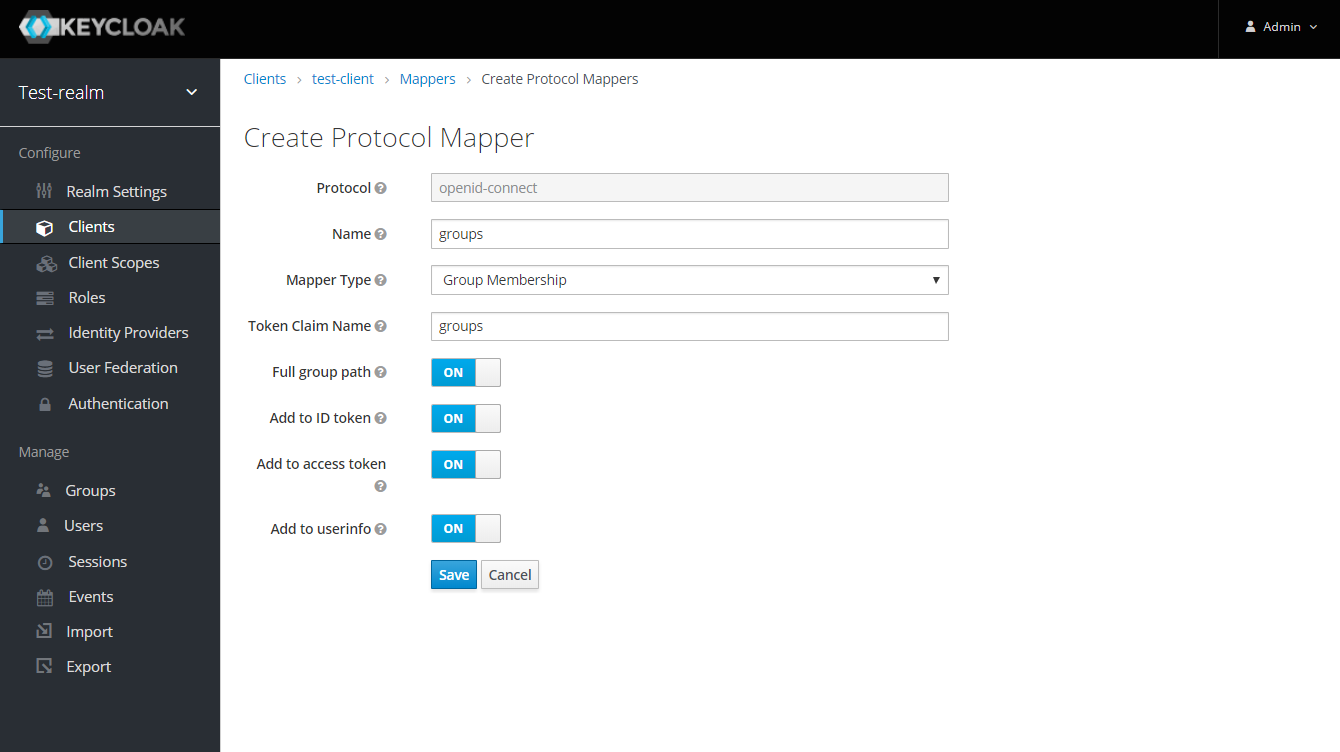
-
To retrieve and map the caller name & groups from token claims, set the caller name & group claim definition to
preferred_username&groups.
@OpenIdAuthenticationDefinition(
providerURI = "http://${keycloak-host}:${keycloak-port}/auth/realms/test-realm",
clientId = "test-client",
clientSecret = "1f6744ae-d7e7-4876-bc44-78fb691316a1"
...
claimsDefinition = @ClaimsDefinition(
callerGroupsClaim = "groups",
callerNameClaim = "preferred_username"
)
)
public class SecurityBean {
}
Extra Resources
To read more about OpenID Connect itself, visit http://openid.net/specs/openid-connect-core-1_0.html
